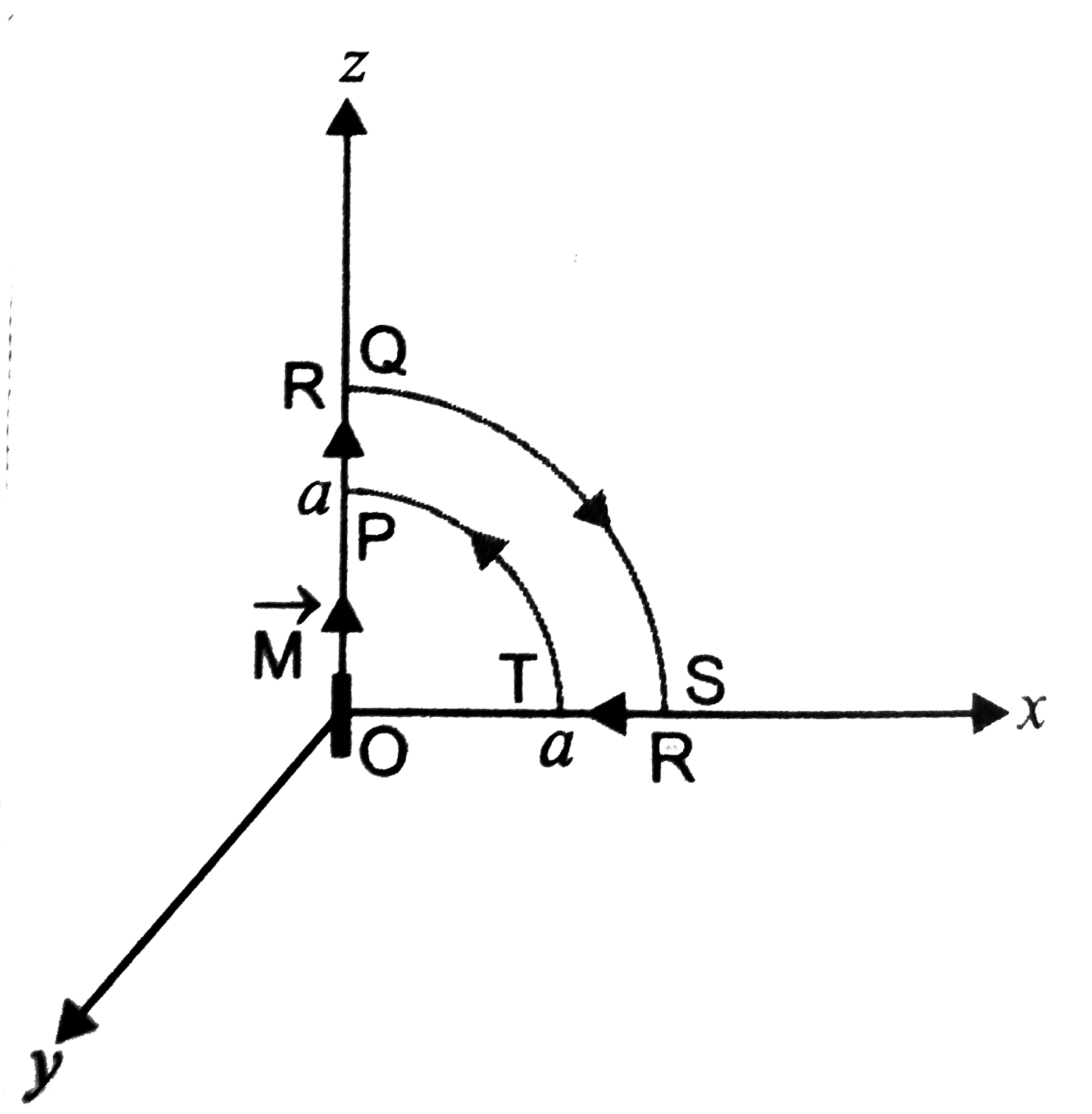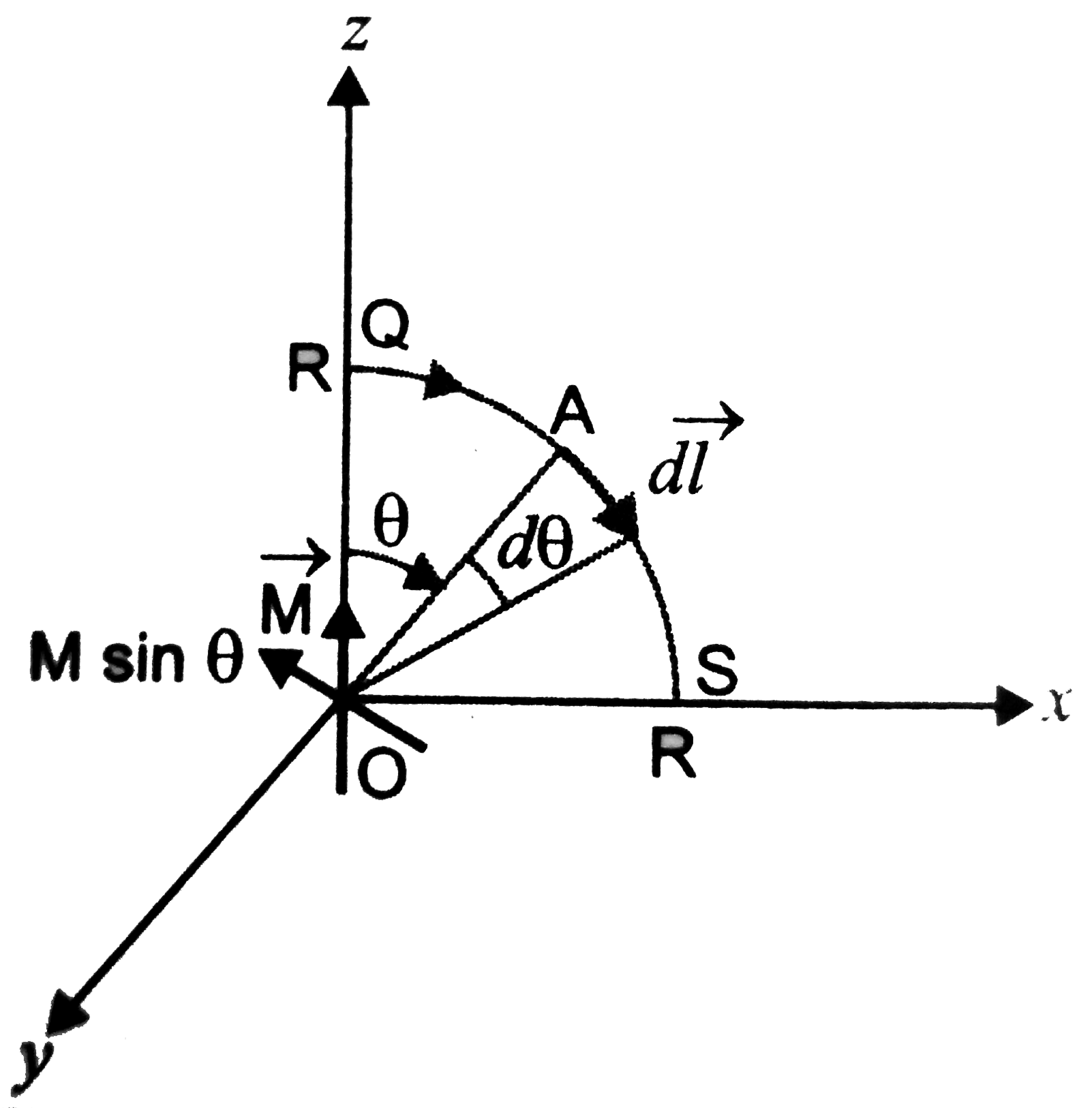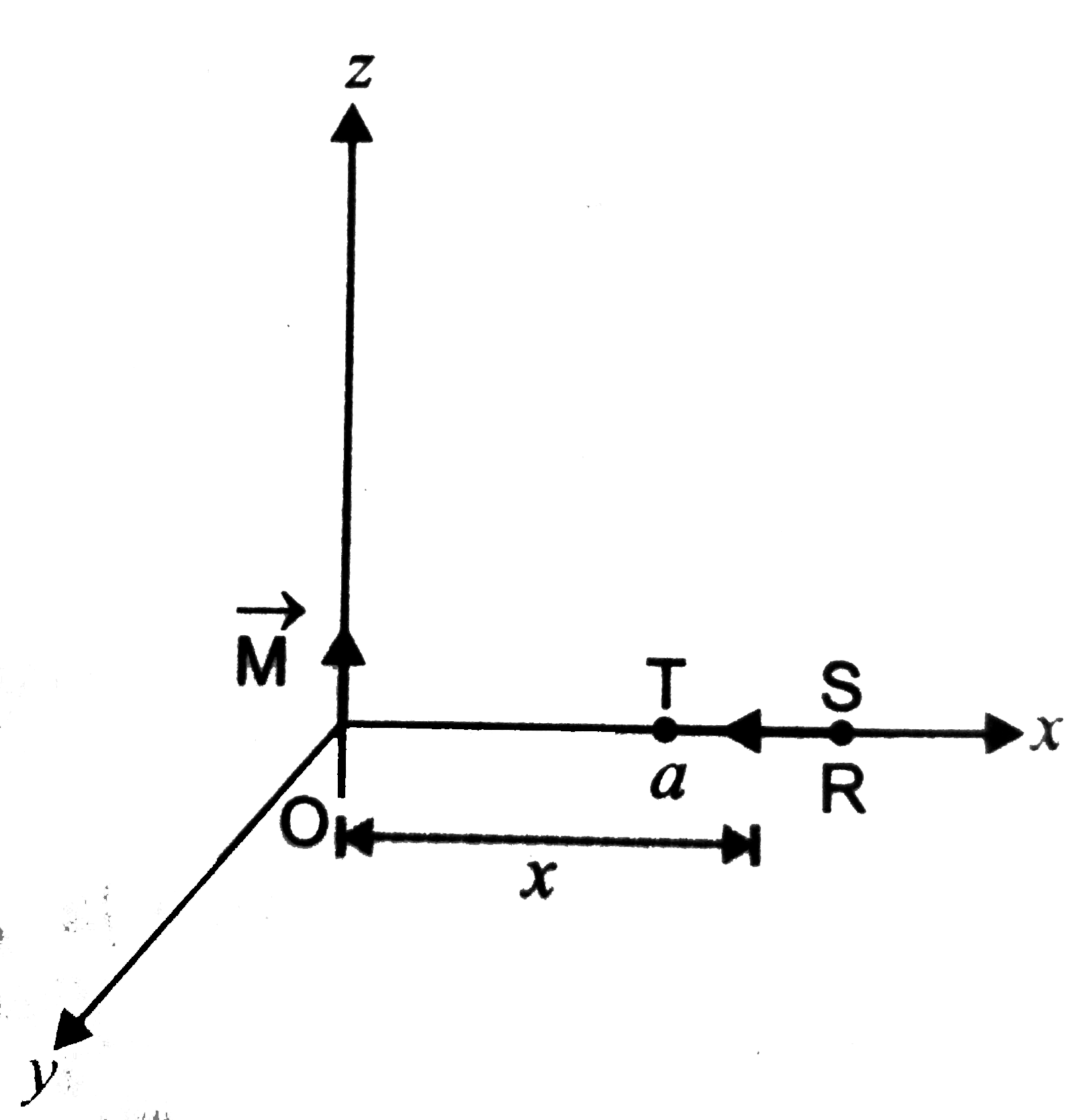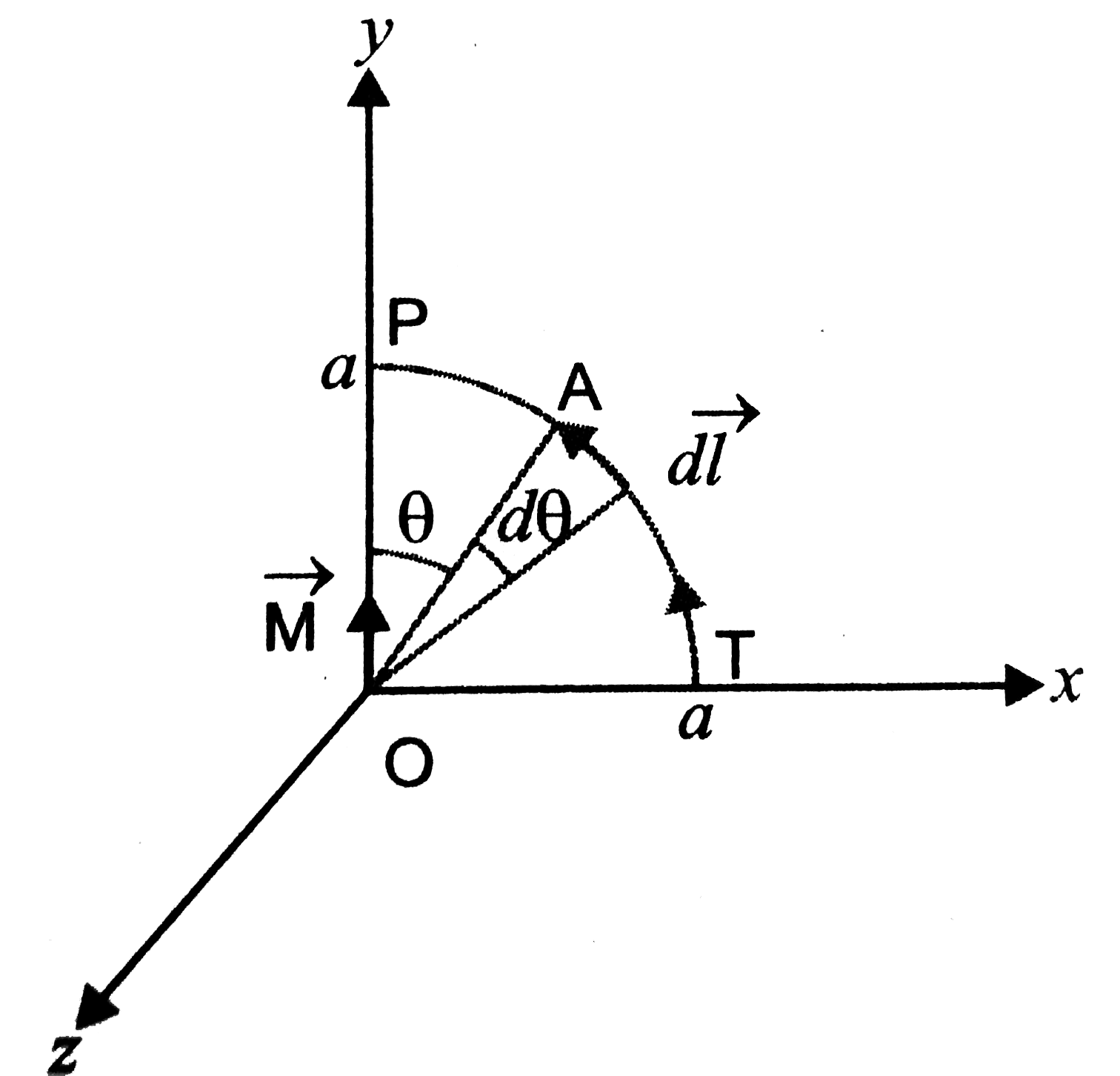Verify the Ampere's law for magnetic field of a point dipole moment →M=Mˆk. Take C as the closed curve running clockwise along (i) z-axis from z=a>0 to z=R, (ii) along the quarter circle of radius R and centre at the origin, in the first quadrant of x-z plane, (iii) along the x-axis from x=R to x=a, and (iv) along the quarter circle of radius a and centre at the origin in the first quadrant of x-y plane.
From P to Q, every point on the z-axis lies at the axial line of magnetic dipole of moment →M. Magnetic field induction at a point distance z from the magnetic dipole of moment →M(=Mˆk) is
∣∣→B∣∣=μ04π2∣∣→M∣∣z3=μ0M2πz3

(i) Along z-axis from P to Q.
∫QP→B.d→l=∫QPBdlcos0∘=∫RaBdz
=∫Raμ02πMz3dz=μ0M2π(−12)(1R2−1a2)=μ0M4π(1a2−1R2)
(ii) Along the quarter circle QS of radius R. point A lies on the equatorial line of the magnetic dipole of moment Msinθ
Magnetic field at point A on the circular arc is
B=μ04πMsinθR3,dl=Rdθ
∴∫circular arcQS→B.d→l=∫Bdlcos0=∫π/20μ04πMsinθR3Rdθ
=μ04πMR2(−cosθ)π/20=μ04πMR2

(iii) Along x-axis over the path ST. every point lies on the equatorial line of magnetic dipole. Magnetic field induction at a point distance x from the dipole is
→B=−μ04π→Mx3
∴∫TS→B.d→l=∫aR−μ0→M4πx3.d→l=0
[∵ angle between (−→M) and d→l is 90∘]

(iv) Along the quarter circle TP of radius a. (ii) Line integral of →B along the quarter circle TP of radius a is
∫circular arcTP→B.d→l=∫0π/2μ04πMsinθa3adθ=μ04π(Ma2)∫0π/2sinthηdθ
=μ04πMa2[−cosθ]0π/2=−μ04πMa2
∴∮PQST→B.d→l=∫QPecB.d→l+∫SQ→B.d→l+∫TSt→B.d→l+∫PT→B.d→l
=μ0M4π[1a2−1R2]+μ04πMR2+0+(−μ04πMa2)=0

Topper's Solved these Questions
- MAGNETIC EFFECT OF CURRENT AND MAGNETISMBook:PRADEEPChapter:MAGNETIC EFFECT OF CURRENT AND MAGNETISMExercise:Conceptual Problems (d)
Explore 2 Videos
- MAGNETIC EFFECT OF CURRENT AND MAGNETISMBook:PRADEEPChapter:MAGNETIC EFFECT OF CURRENT AND MAGNETISMExercise:Very Short Answer Questions (a)
Explore 2 Videos
- ELECTROSTATICSBook:PRADEEPChapter:ELECTROSTATICSExercise:ASSERTION-REASON TYPE QUESTIONS
Explore 2 Videos
- OPTICSBook:PRADEEPChapter:OPTICSExercise:Multiple choice questions
Explore 1 Video
Similar Questions
Verify the Gauss's law for magnetic field of a point dipole of dipole moment M at the origin for the surface which is a sphere of radius R.
View SolutionA circle of radius 4 units touches the cordinate axes in the first quadrant. If the circle makes one compete roll on the x-axis along the positive direction of x-axis, find its equation in new position .
View Solution
Knowledge Check
Equation of circle of radius 5, centred on X -axis and
passing through origin , isAx2+y2±10x=0Bx2+y2±10y=0Cx2+y2±10x±10y=0Dx2+y2=10A circle of radius 5 units touches both the axes and lies in the first quadrant. If the circle makes one complete roll on x-axis along the positive direction of x-axis, then its equation in the new position is
Ax2+y2+20πx−10y+100π2=0Bx2+y2+20πx+10y+100π2=0Cx2+y2−20πx−10y+100π2=0DNone of the aboveA circle of radius 5 units touches both the axes and lies in the first quadrant. If the circle makes one complete roll on x-axis along the positive direction of x-axis, then its equation in the new position is
Ax2+y2+20πx−10y+100π2=0Bx2+y2+20πx+10y+100π2=0Cx2+y2−20πx−10y+100π2=0Dnone of these
A circle of radius 2 units touches the co ordinate axes in the first quadrant. If the circle makes a complete rotation on the x-axis along the positive direction of the x-axis, then the equation of the circle in the new position is
View SolutionA current carrying loop consists of 3 identical quarter circles of radius R, lying in the positive quadrants of the x-y, y-z and z-x planes with their centres at the origin, joined together. Find the direction and magnitude to →B at the origin.
View SolutionA ray along x−y−6=0 incidents on x-axis at (6,0) and the reflected ray touches a circle with centre at origin having radius
View SolutionA current I flows along a round circular loop of radius R. Find the line integration of magnetic field along the axis of the loop from center to ∞
View SolutionA 4 A current carrying loop consists of three identical quarter circles of radius 5 cm lying in the positive quadrants of the x-y, y-z and z-x planes with their centres at the origin joined together, value of B at the origin is
View Solution

